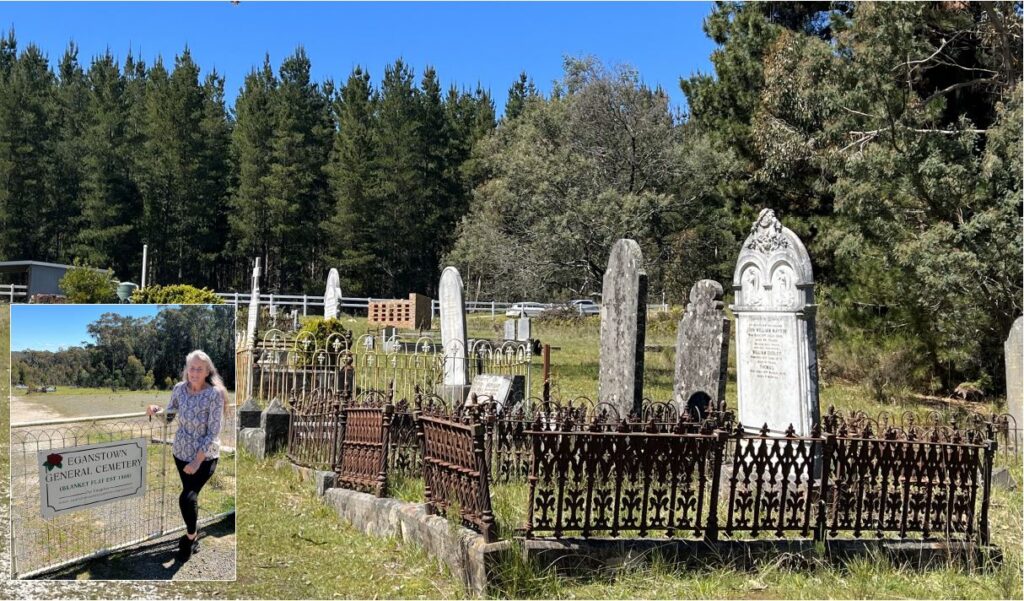November 9th, 2023Eganstown Cemetery: beautiful bush setting
Words: Donna Kelly | Images: Beck Walker

It was established in 1866 as the Blanket Flat Cemetery and in recent years, according to trust chairperson Loris Duclos, Eganstown General Cemetery has “really kicked some goals”.
The first project was building a crematorium wall so the cemetery can now take ashes. The project was funded by the Department of Health and trust savings, and built by local contractor Shane Moiler.
“Shane did a fantastic job for us and we have got our first ashes in the wall which is very exciting for our beautiful old cemetery,” Loris says. “In the past we had only had one or two burials a year, but we have had five or six in the past years, our business is getting busier.”
Loris said, like many old cemeteries, there had been a big pine plantation in the front but that had been harvested about a decade ago and was now a carparking area, much safer for those visiting the Cemetery Road site.
And while there are fortunately no grave robbers, there have unbelievably been water tank robbers, twice, but a local Smokeytown business stepped up after a Facebook post, and have donated and fitted, with locks, a new water tank.
“We feel like we have really had good input from the community and that is something worth celebrating for our really old cemetery.”
Loris said most recently new people had joined the committee and “helped us reinvigorate the trust and build a new fence from recycled plastics”.
“It is bloody beautiful and will never need to be painted – and our old fence was coming up to 60 years of age. That is our most recent project and it’s wonderful.”
Loris said the future was looking interesting with a ground-penetrating radar to be used to find unmarked graves.
“We know that during the goldrush, for example, if a baby died they would just be buried without a record, and we also have a section at the back for paupers and those graves remain unmarked.
“We are very excited by this new project and an initial review by Dave the Graveman has found about 100 unnamed gravesites. It is really wonderful and enables us to plan for our cemetery better.”
Loris said she had joined the Trust after her grand-daughter was buried at the cemetery. “The cemetery on the main road is St Francis Xavier, and one of the only Catholic cemeteries in Australia, ours is Eganstown General Cemetery and we took all religions and paupers.
“It lies a few kilometres up Cemetery Road and is a beautiful peaceful bush cemetery. It was a place where I could honour my grand-daughter and I love the bush. It just gives that feel of a quiet bush place where you can contemplate away from the traffic.”
“And I love being a part of the lineage of locals and a part of the history and those people who have done a lot of research to put names to people who might be there, based on newspapers and research at the (Daylesford) museum.
“Since being on the Trust I have learned a lot about how we bury people and care for their remains and how we keep track of records, it is all very interesting stuff particularly if you have a penchant for history and genealogy.”
Eganstown history snippet
Mr John Egan, the founder of the township which bears his name, and who throughout his life had proved himself a good Catholic, a patriotic Irishman, as well as an excellent colonist.
Mr Egan was a native of Borrisoleigh, in the County Tipperary, and arrived in the colony in 1841. Seven years later he founded the present Eganstown, which lies four miles beyond Daylesford, on the Creswick side.
Here he took up a large selection, as well as an extensive grazing area, and by his indomitable pluck and energy earned a name for himself that will live in the annals of our early pioneers.
He died in 1890, at the age of 85 years, he was the first to discover gold in the Daylesford district, in 1851.










